tires LEXUS GS300H 2019 Owners Manual
[x] Cancel search | Manufacturer: LEXUS, Model Year: 2019, Model line: GS300H, Model: LEXUS GS300H 2019Pages: 600, PDF Size: 55.99 MB
Page 5 of 600
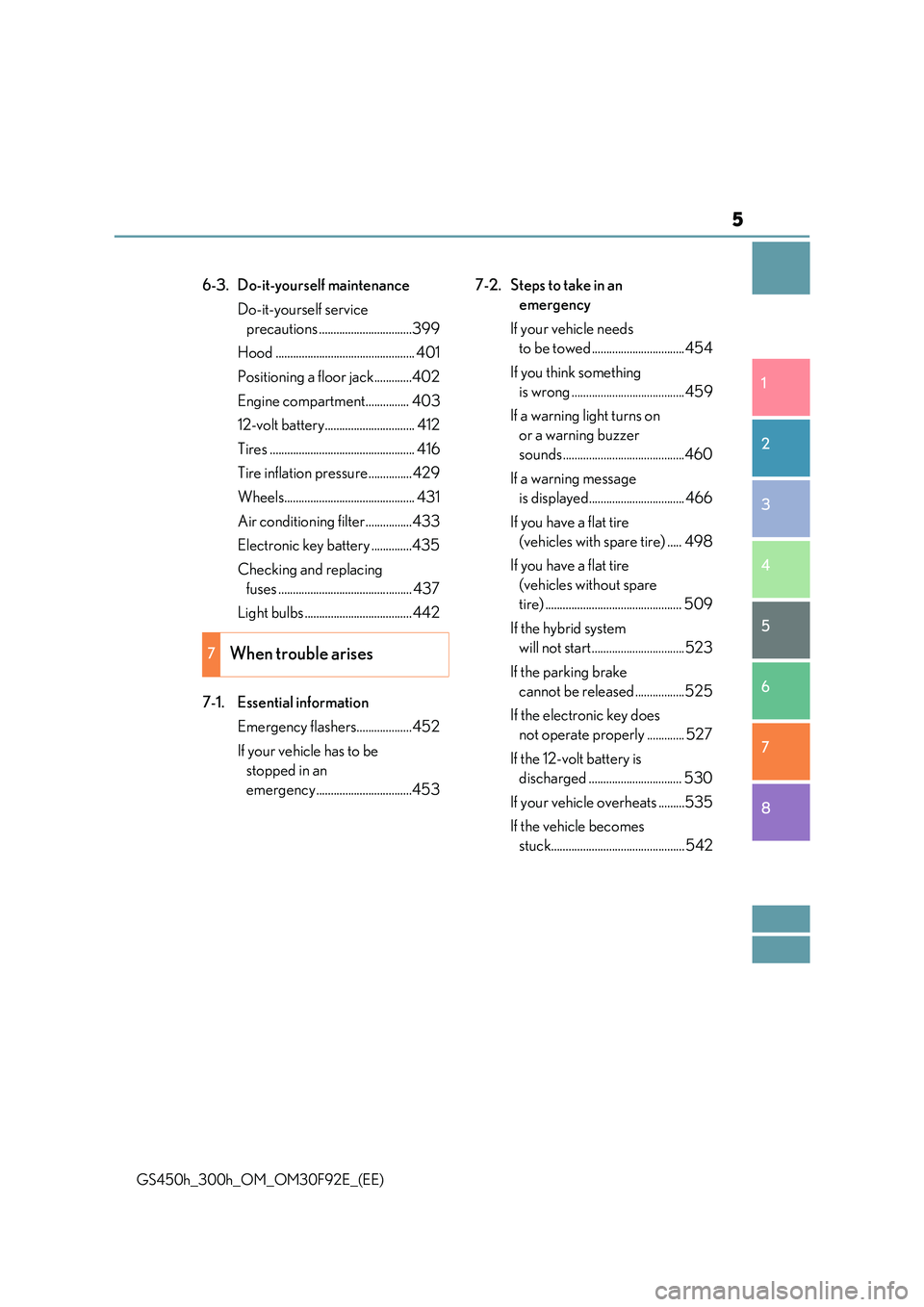
5
1
8
7
6
5
4
3
2
GS450h_300h_OM_OM30F92E_(EE)
6-3. Do-it-yourself maintenance
Do-it-yourself service
precautions ................................399
Hood ................................................ 401
Positioning a floor jack.............402
Engine compartment............... 403
12-volt battery............................... 412
Tires .................................................. 416
Tire inflation pressure...............429
Wheels............................................. 431
Air conditioning filter................433
Electronic key battery ..............435
Checking and replacing
fuses .............................................. 437
Light bulbs ..................................... 442
7-1. Essential information
Emergency flashers...................452
If your vehicle has to be
stopped in an
emergency.................................453
7-2. Steps to take in an
emergency
If your vehicle needs
to be towed ................................454
If you think something
is wrong .......................................459
If a warning light turns on
or a warning buzzer
sounds..........................................460
If a warning message
is displayed................................. 466
If you have a flat tire
(vehicles with spare tire) ..... 498
If you have a flat tire
(vehicles without spare
tire) ............................................... 509
If the hybrid system
will not start................................523
If the parking brake
cannot be released.................525
If the electronic key does
not operate properly ............. 527
If the 12-volt battery is
discharged ................................ 530
If your vehicle overheats .........535
If the vehicle becomes
stuck.............................................. 542
7When trouble arises
Page 15 of 600
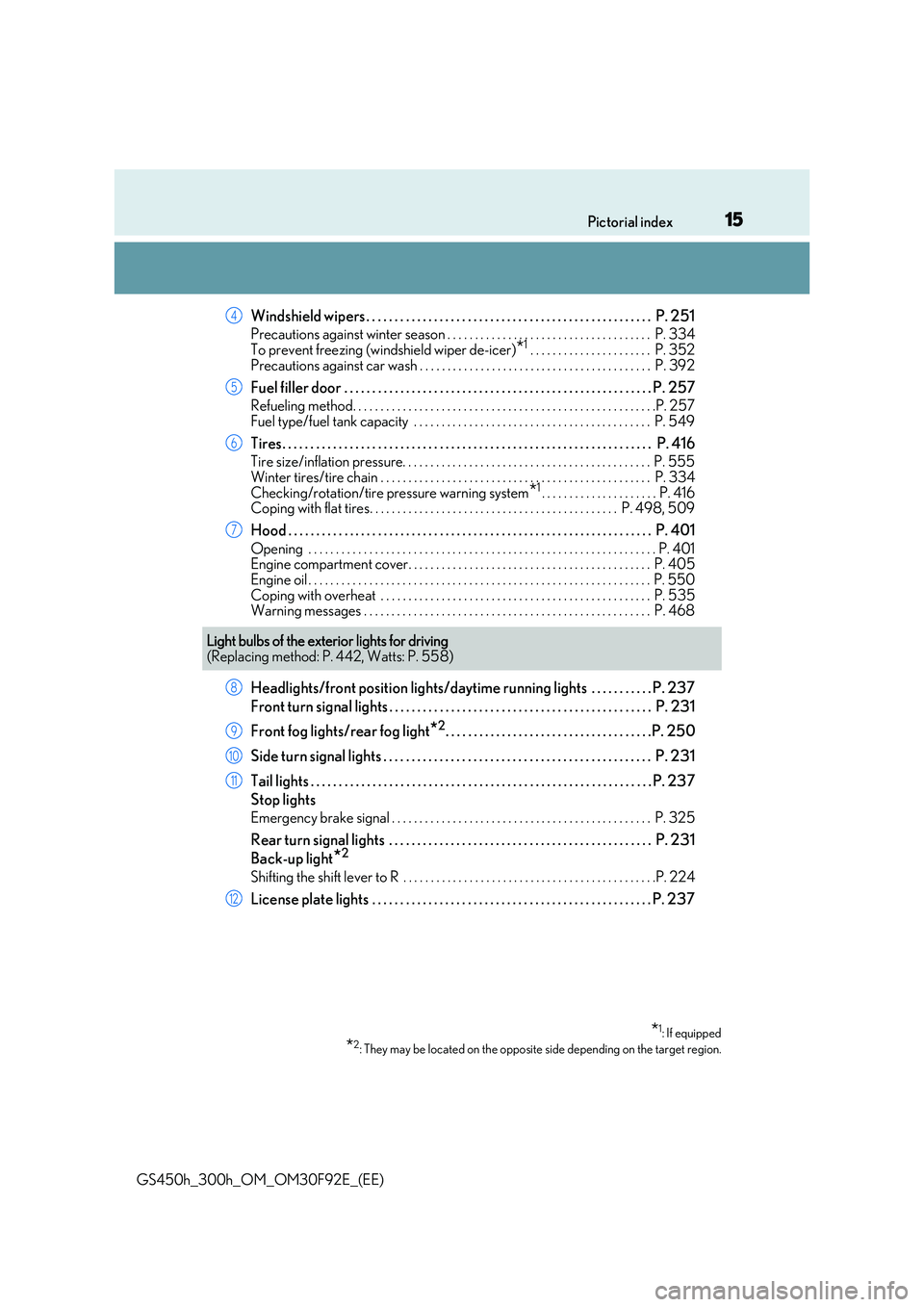
15Pictorial index
GS450h_300h_OM_OM30F92E_(EE)
Windshield wipers . . . . . . . . . . . . . . . . . . . . . . . . . . . . . . . . . . . . . . . . . . . . . . . . . . . P. 251
Precautions against winter season . . . . . . . . . . . . . . . . . . . . . . . . . . . . . . . . . . . . . P. 334
To prevent freezing (windshield wiper de-icer)*1 . . . . . . . . . . . . . . . . . . . . . . P. 352 Precautions against car wash . . . . . . . . . . . . . . . . . . . . . . . . . . . . . . . . . . . . . . . . . . P. 392
Fuel filler door . . . . . . . . . . . . . . . . . . . . . . . . . . . . . . . . . . . . . . . . . . . . . . . . . . . . . . . P . 257
Refueling method. . . . . . . . . . . . . . . . . . . . . . . . . . . . . . . . . . . . . . . . . . . . . . . . . . . . . . .P. 257 Fuel type/fuel tank capacity . . . . . . . . . . . . . . . . . . . . . . . . . . . . . . . . . . . . . . . . . . . P. 549
Tires. . . . . . . . . . . . . . . . . . . . . . . . . . . . . . . . . . . . . . . . . . . . . . . . . . . . . . . . . . . . . . . . . . P. 416
Tire size/inflation pressure. . . . . . . . . . . . . . . . . . . . . . . . . . . . . . . . . . . . . . . . . . . . . P. 555 Winter tires/tire chain . . . . . . . . . . . . . . . . . . . . . . . . . . . . . . . . . . . . . . . . . . . . . . . . . P. 33 4
Checking/rotation/tire pressure warning system*1. . . . . . . . . . . . . . . . . . . . . P. 416 Coping with flat tires. . . . . . . . . . . . . . . . . . . . . . . . . . . . . . . . . . . . . . . . . . . . . P. 498, 509
Hood . . . . . . . . . . . . . . . . . . . . . . . . . . . . . . . . . . . . . . . . . . . . . . . . . . . . . . . . . . . . . . . . . P. 401
Opening . . . . . . . . . . . . . . . . . . . . . . . . . . . . . . . . . . . . . . . . . . . . . . . . . . . . . . . . . . . . . . . P. 401 Engine compartment cover. . . . . . . . . . . . . . . . . . . . . . . . . . . . . . . . . . . . . . . . . . . . P. 405Engine oil . . . . . . . . . . . . . . . . . . . . . . . . . . . . . . . . . . . . . . . . . . . . . . . . . . . . . . . . . . . . . . P. 550
Coping with overheat . . . . . . . . . . . . . . . . . . . . . . . . . . . . . . . . . . . . . . . . . . . . . . . . . P. 535 Warning messages . . . . . . . . . . . . . . . . . . . . . . . . . . . . . . . . . . . . . . . . . . . . . . . . . . . . P. 468
Headlights/front position lights/daytime running lights . . . . . . . . . . . P. 237
Front turn signal lights . . . . . . . . . . . . . . . . . . . . . . . . . . . . . . . . . . . . . . . . . . . . . . . P. 231
Front fog lights/rear fog light*2. . . . . . . . . . . . . . . . . . . . . . . . . . . . . . . . . . . . .P. 250
Side turn signal lights . . . . . . . . . . . . . . . . . . . . . . . . . . . . . . . . . . . . . . . . . . . . . . . . P. 231
Tail lights . . . . . . . . . . . . . . . . . . . . . . . . . . . . . . . . . . . . . . . . . . . . . . . . . . . . . . . . . . . . . P. 237
Stop lights
Emergency brake signal . . . . . . . . . . . . . . . . . . . . . . . . . . . . . . . . . . . . . . . . . . . . . . . P. 325
Rear turn signal lights . . . . . . . . . . . . . . . . . . . . . . . . . . . . . . . . . . . . . . . . . . . . . . . P. 231
Back-up light*2
Shifting the shift lever to R . . . . . . . . . . . . . . . . . . . . . . . . . . . . . . . . . . . . . . . . . . . . . .P. 224
License plate lights . . . . . . . . . . . . . . . . . . . . . . . . . . . . . . . . . . . . . . . . . . . . . . . . . . P. 237
4
5
6
7
Light bulbs of the exterior lights for driving
(Replacing method: P. 442, Watts: P. 558)
*1: If equipped
*2: They may be located on the opposite side depending on the target region.
8
9
10
11
12
Page 96 of 600
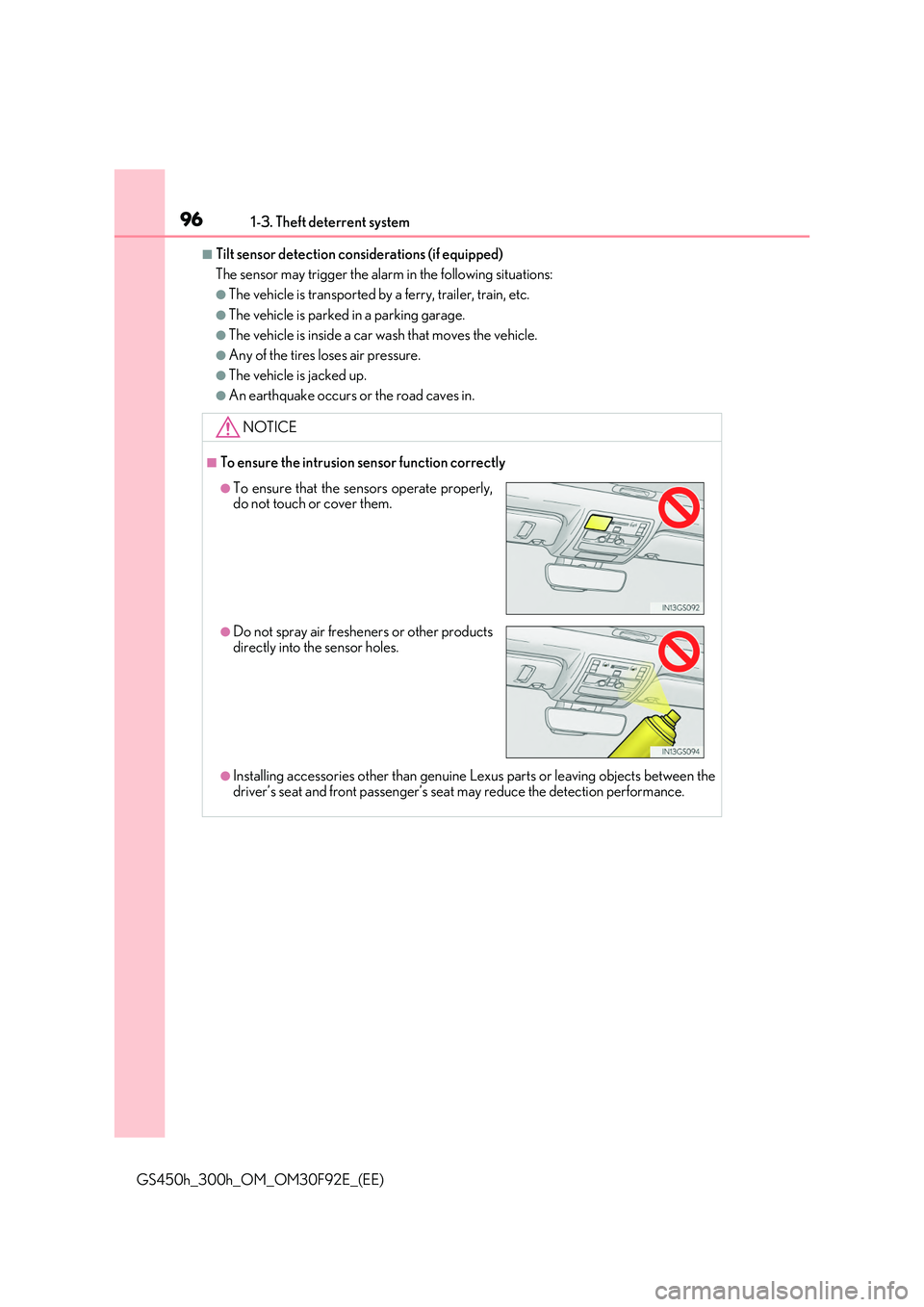
961-3. Theft deterrent system
GS450h_300h_OM_OM30F92E_(EE)
■Tilt sensor detection considerations (if equipped)
The sensor may trigger the alarm in the following situations:
●The vehicle is transported by a ferry, trailer, train, etc.
●The vehicle is parked in a parking garage.
●The vehicle is inside a car wash that moves the vehicle.
●Any of the tires loses air pressure.
●The vehicle is jacked up.
●An earthquake occurs or the road caves in.
NOTICE
■To ensure the intrusion sensor function correctly
●Installing accessories other than genuine Lexus parts or leaving objects between the
driver’s seat and front passenger’s seat may reduce the detection performance.
●To ensure that the sensors operate properly, do not touch or cover them.
●Do not spray air freshe ners or other products directly into the sensor holes.
Page 201 of 600
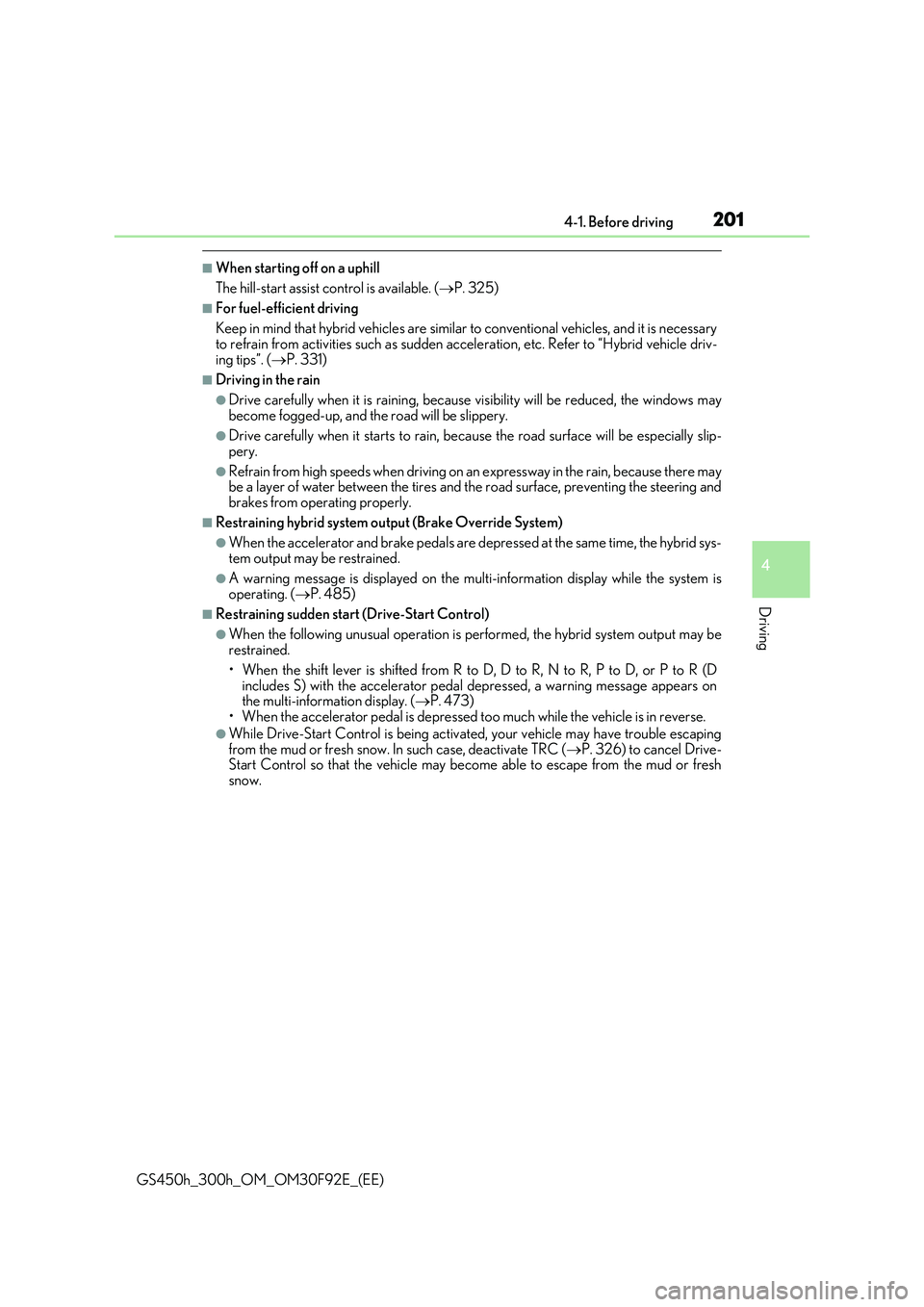
2014-1. Before driving
4
Driving
GS450h_300h_OM_OM30F92E_(EE)
■When starting off on a uphill
The hill-start assist control is available. ( P. 325)
■For fuel-efficient driving
Keep in mind that hybrid vehicles are similar to conventional vehicles, and it is necessary
to refrain from activities such as sudden acceleration, etc. Refer to “Hybrid vehicle driv- ing tips”. ( P. 331)
■Driving in the rain
●Drive carefully when it is raining, because visibility will be reduced, the windows may become fogged-up, and the road will be slippery.
●Drive carefully when it starts to rain, because the road surface will be especially slip-
pery.
●Refrain from high speeds when driving on an expressway in the rain, because there may be a layer of water between the tires and the road surface, preventing the steering and
brakes from operating properly.
■Restraining hybrid system outp ut (Brake Override System)
●When the accelerator and brake pedals are depressed at the same time, the hybrid sys-
tem output may be restrained.
●A warning message is displayed on the mult i-information display while the system is operating. ( P. 485)
■Restraining sudden start (Drive-Start Control)
●When the following unusual operation is performed, the hybrid system output may be restrained.
• When the shift lever is shifted from R to D, D to R, N to R, P to D, or P to R (D includes S) with the accelerator pedal depressed, a warning message appears onthe multi-information display. ( P. 473)
• When the accelerator pedal is depressed t oo much while the vehicle is in reverse.
●While Drive-Start Control is being activated, your vehicle may have trouble escaping
from the mud or fresh snow. In such case, deactivate TRC ( P. 326) to cancel Drive- Start Control so that the vehicle may become able to escape from the mud or freshsnow.
Page 206 of 600
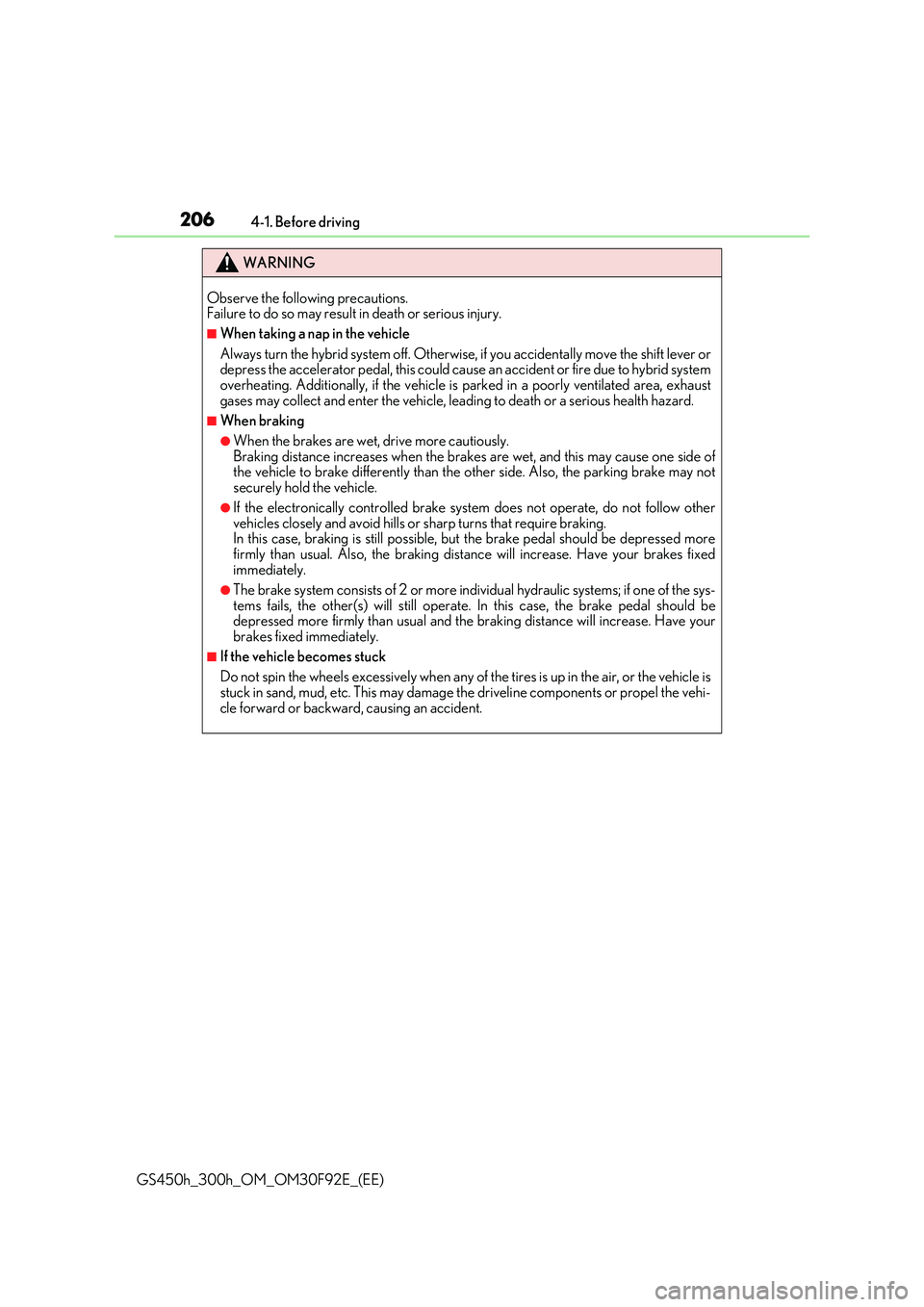
2064-1. Before driving
GS450h_300h_OM_OM30F92E_(EE)
WARNING
Observe the following precautions. Failure to do so may result in death or serious injury.
■When taking a nap in the vehicle
Always turn the hybrid system off. Otherwise, if you accidentally move the shift lever or depress the accelerator pedal, this could cause an accident or fire due to hybrid systemoverheating. Additionally, if the vehicle is parked in a poorly ventilated area, exhaust
gases may collect and enter the vehicle, lead ing to death or a serious health hazard.
■When braking
●When the brakes are wet, drive more cautiously.
Braking distance increases when the brakes are wet, and this may cause one side of the vehicle to brake differently than the other side. Also, the parking brake may notsecurely hold the vehicle.
●If the electronically controlled brake system does not operate, do not follow othervehicles closely and avoid hills or sharp turns that require braking. In this case, braking is st ill possible, but the brake pedal should be depressed more
firmly than usual. Also, the braking distance will increase. Have your brakes fixed immediately.
●The brake system consists of 2 or more indi vidual hydraulic systems; if one of the sys-
tems fails, the other(s) will still operate. In this case, the brake pedal should be depressed more firmly than usual and the braking distance will increase. Have your brakes fixed immediately.
■If the vehicle becomes stuck
Do not spin the wheels excessively when any of the tires is up in the air, or the vehicle is stuck in sand, mud, etc. This may damage the driveline components or propel the vehi-
cle forward or backward, causing an accident.
Page 212 of 600
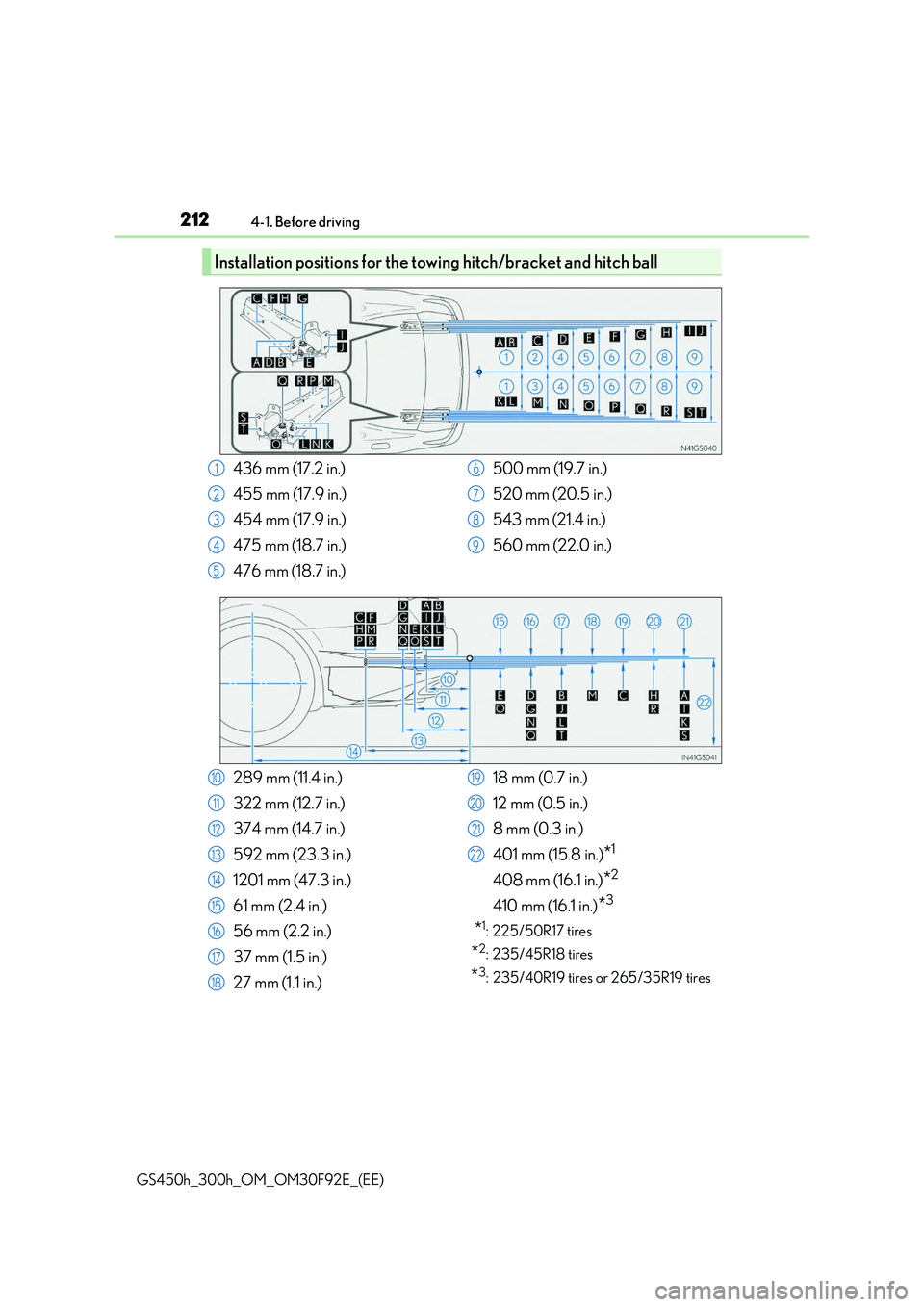
2124-1. Before driving
GS450h_300h_OM_OM30F92E_(EE)
Installation positions for the towing hitch/bracket and hitch ball
436 mm (17.2 in.)
455 mm (17.9 in.)
454 mm (17.9 in.)
475 mm (18.7 in.)
476 mm (18.7 in.)
500 mm (19.7 in.)
520 mm (20.5 in.)
543 mm (21.4 in.)
560 mm (22.0 in.)
1
2
3
4
5
6
7
8
9
289 mm (11.4 in.)
322 mm (12.7 in.)
374 mm (14.7 in.)
592 mm (23.3 in.)
1201 mm (47.3 in.)
61 mm (2.4 in.)
56 mm (2.2 in.)
37 mm (1.5 in.)
27 mm (1.1 in.)
18 mm (0.7 in.)
12 mm (0.5 in.)
8 mm (0.3 in.)
401 mm (15.8 in.)*1
408 mm (16.1 in.)*2
410 mm (16.1 in.)*3
*1:225/50R17 tires
*2:235/45R18 tires
*3: 235/40R19 tires or 265/35R19 tires
10
11
12
13
14
15
16
17
18
19
20
21
22
Page 213 of 600
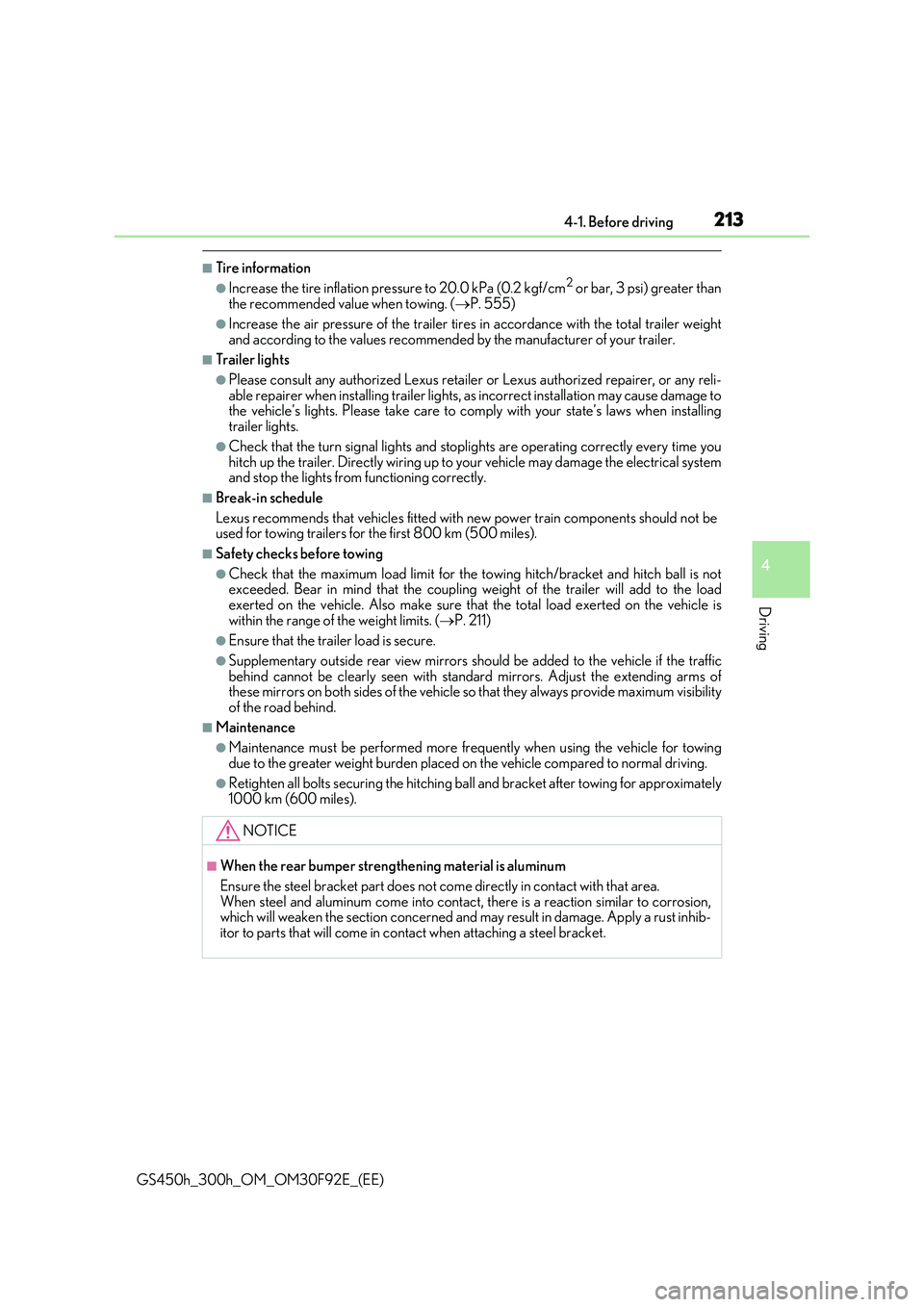
2134-1. Before driving
4
Driving
GS450h_300h_OM_OM30F92E_(EE)
■Tire information
●Increase the tire inflation pressure to 20.0 kPa (0.2 kgf/cm2 or bar, 3 psi) greater than the recommended value when towing. ( P. 555)
●Increase the air pressure of the trailer tires in accordance with the total trailer weight
and according to the values recommended by the manufacturer of your trailer.
■Trailer lights
●Please consult any authorized Lexus retailer or Lexus authorized repairer, or any reli-
able repairer when installing trailer lights, as incorrect installation may cause damage to the vehicle’s lights. Please take care to comply with your state’s laws when installingtrailer lights.
●Check that the turn signal lights and stoplights are operating correctly every time youhitch up the trailer. Directly wiring up to your vehicle may damage the electrical systemand stop the lights from functioning correctly.
■Break-in schedule
Lexus recommends that vehicles fitted with new power train components should not be used for towing trailers for the first 800 km (500 miles).
■Safety checks before towing
●Check that the maximum load limit for the towing hitch/bracket and hitch ball is not exceeded. Bear in mind that the coupling weight of the trailer will add to the load
exerted on the vehicle. Also make sure that the total load exerted on the vehicle is within the range of the weight limits. ( P. 211)
●Ensure that the trailer load is secure.
●Supplementary outside rear view mirrors should be added to the vehicle if the traffic behind cannot be clearly seen with standard mirrors. Adjust the extending arms ofthese mirrors on both sides of the vehicle so that they always provide maximum visibility
of the road behind.
■Maintenance
●Maintenance must be performed more frequently when using the vehicle for towing
due to the greater weight burden placed on the vehicle compared to normal driving.
●Retighten all bolts securing the hitching ball and bracket after towing for approximately 1000 km (600 miles).
NOTICE
■When the rear bumper strengthening material is aluminum
Ensure the steel bracket part does not come directly in contact with that area. When steel and aluminum come into contact, there is a reaction similar to corrosion,which will weaken the section concerned and may result in damage. Apply a rust inhib-
itor to parts that will come in co ntact when attaching a steel bracket.
Page 236 of 600
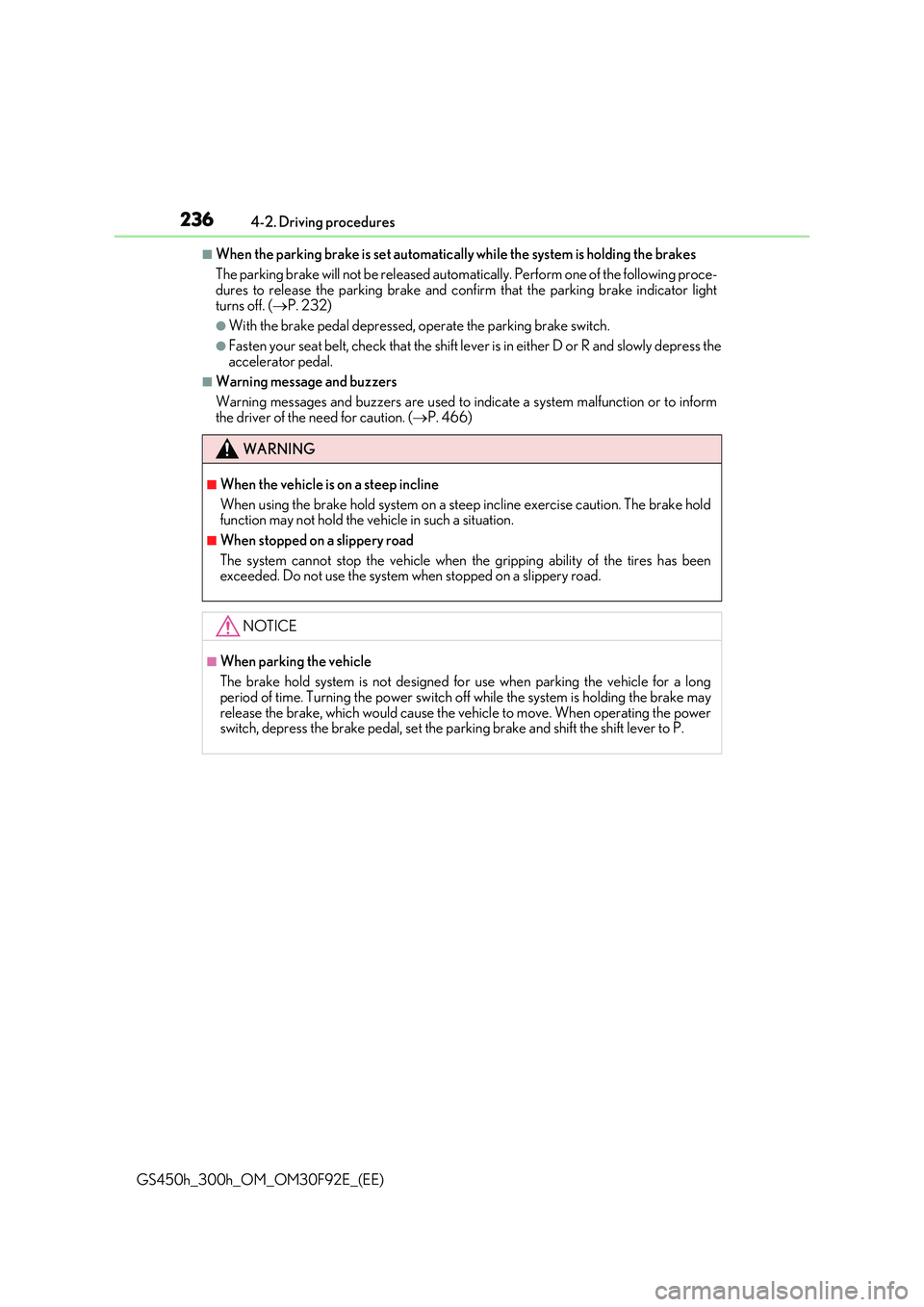
2364-2. Driving procedures
GS450h_300h_OM_OM30F92E_(EE)
■When the parking brake is set automatically while the system is holding the brakes
The parking brake will not be released auto matically. Perform one of the following proce- dures to release the parking brake and conf irm that the parking brake indicator light
turns off. ( P. 232)
●With the brake pedal depressed, operate the parking brake switch.
●Fasten your seat belt, check that the shift lever is in either D or R and slowly depress the
accelerator pedal.
■Warning message and buzzers
Warning messages and buzzers are used to indicate a system malfunction or to inform
the driver of the need for caution. ( P. 466)
WARNING
■When the vehicle is on a steep incline
When using the brake hold system on a steep incline exercise caution. The brake hold function may not hold the vehicle in such a situation.
■When stopped on a slippery road
The system cannot stop the vehicle when the gripping ability of the tires has been exceeded. Do not use the system when stopped on a slippery road.
NOTICE
■When parking the vehicle
The brake hold system is not designed fo r use when parking the vehicle for a long
period of time. Turning the power switch o ff while the system is holding the brake may release the brake, which would cause the vehicle to move. When operating the powerswitch, depress the brake pedal, set the pa rking brake and shift the shift lever to P.
Page 272 of 600
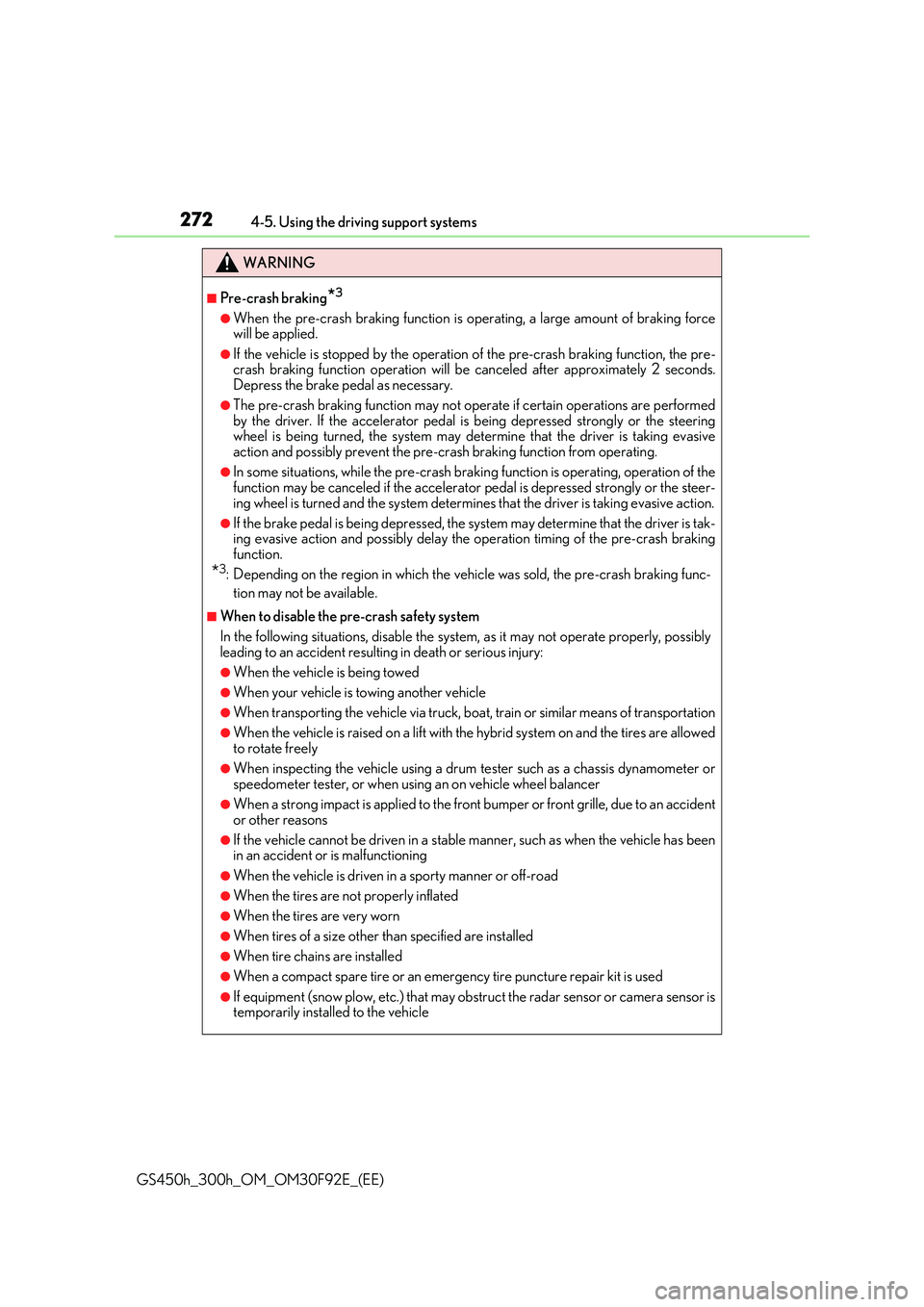
2724-5. Using the driving support systems
GS450h_300h_OM_OM30F92E_(EE)
WARNING
■Pre-crash braking*3
●When the pre-crash braking function is operating, a large amount of braking force will be applied.
●If the vehicle is stopped by the operation of the pre-crash braking function, the pre-crash braking function operation will be canceled after approximately 2 seconds.Depress the brake pedal as necessary.
●The pre-crash braking function may not operate if certain operations are performedby the driver. If the accelerator pedal is being depressed strongly or the steeringwheel is being turned, the system may determine that the driver is taking evasive
action and possibly prevent the pre-crash braking function from operating.
●In some situations, while the pre-crash braking function is operating, operation of thefunction may be canceled if the accelerator pedal is depressed strongly or the steer-
ing wheel is turned and the system determines that the driver is taking evasive action.
●If the brake pedal is being depressed, the system may determine that the driver is tak-ing evasive action and possibly delay the operation timing of the pre-crash braking
function.
*3: Depending on the region in which the vehicle was sold, the pre-crash braking func-
tion may not be available.
■When to disable the pre-crash safety system
In the following situations, disable the system, as it may not operate properly, possibly
leading to an accident resulting in death or serious injury:
●When the vehicle is being towed
●When your vehicle is towing another vehicle
●When transporting the vehicle via truck, boat, train or similar means of transportation
●When the vehicle is raised on a lift with the hybrid system on and the tires are allowed to rotate freely
●When inspecting the vehicle using a drum tester such as a chassis dynamometer orspeedometer tester, or when using an on vehicle wheel balancer
●When a strong impact is applied to the front bumper or front grille, due to an accident
or other reasons
●If the vehicle cannot be driven in a stable manner, such as when the vehicle has beenin an accident or is malfunctioning
●When the vehicle is driven in a sporty manner or off-road
●When the tires are not properly inflated
●When the tires are very worn
●When tires of a size other than specified are installed
●When tire chains are installed
●When a compact spare tire or an emergency tire puncture repair kit is used
●If equipment (snow plow, etc.) that may obstruct the radar sensor or camera sensor istemporarily installed to the vehicle
Page 280 of 600
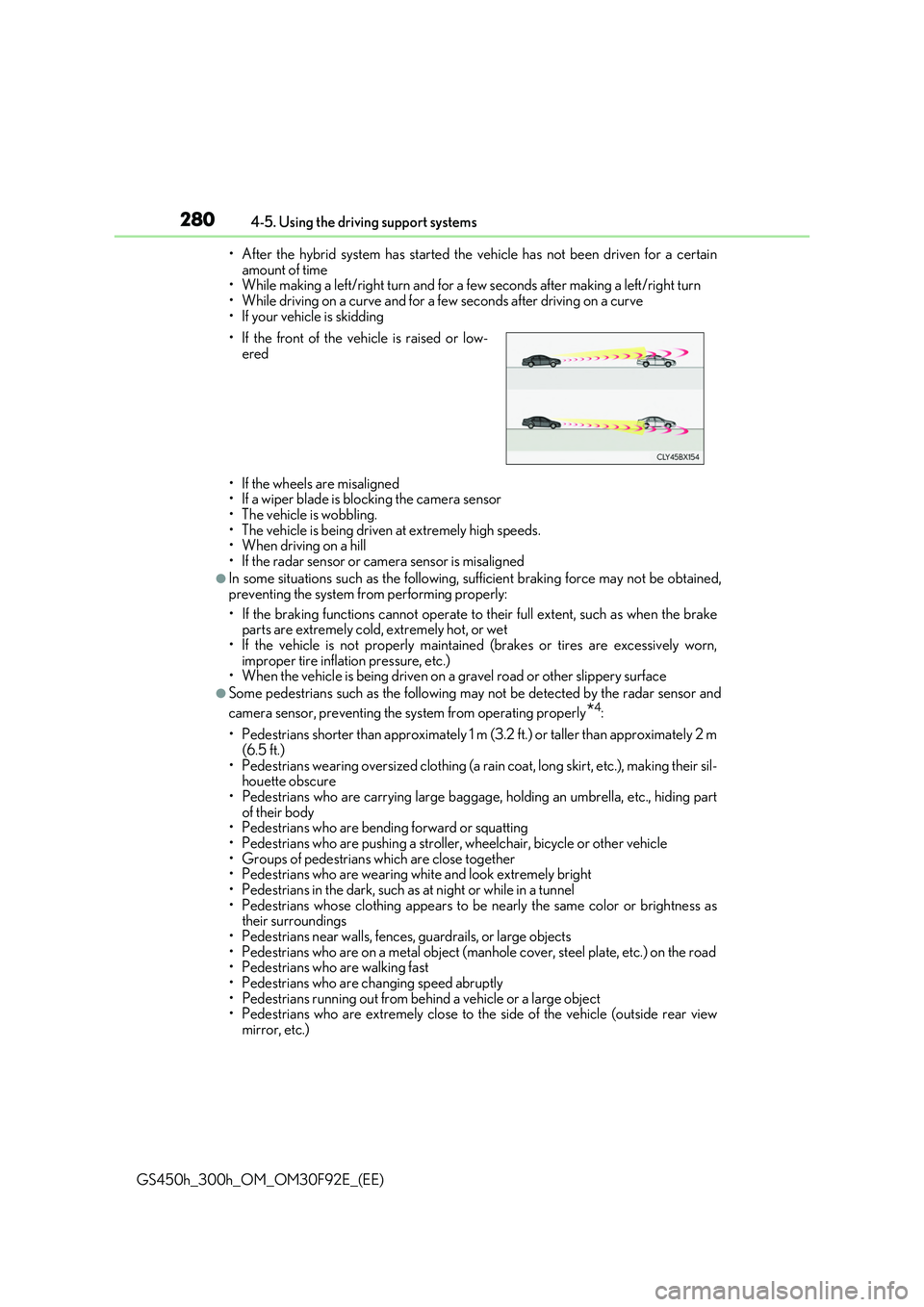
2804-5. Using the driving support systems
GS450h_300h_OM_OM30F92E_(EE)
• After the hybrid system has started the vehicle has not been driven for a certain amount of time• While making a left/right turn and for a few seconds after making a left/right turn
• While driving on a curve and for a few seconds after driving on a curve • If your vehicle is skidding
• If the wheels are misaligned • If a wiper blade is blocking the camera sensor
• The vehicle is wobbling. • The vehicle is being driven at extremely high speeds.• When driving on a hill
• If the radar sensor or camera sensor is misaligned
●In some situations such as the following, sufficient braking force may not be obtained,
preventing the system from performing properly:
• If the braking functions cannot operate to their full extent, such as when the brake parts are extremely cold, extremely hot, or wet
• If the vehicle is not properly maintained (brakes or tires are excessively worn, improper tire inflation pressure, etc.)• When the vehicle is being driven on a gravel road or other slippery surface
●Some pedestrians such as the following may not be detected by the radar sensor and
camera sensor, preventing the system from operating properly*4:
• Pedestrians shorter than approximately 1 m (3 .2 ft.) or taller than approximately 2 m
(6.5 ft.) • Pedestrians wearing oversized clothing (a rain coat, long skirt, etc.), making their sil- houette obscure
• Pedestrians who are carrying large baggage, holding an umbrella, etc., hiding part of their body• Pedestrians who are bending forward or squatting
• Pedestrians who are pushing a stroller , wheelchair, bicycle or other vehicle • Groups of pedestrians which are close together• Pedestrians who are wearing white and look extremely bright
• Pedestrians in the dark, such as at night or while in a tunnel • Pedestrians whose clothing appears to be nearly the same color or brightness astheir surroundings
• Pedestrians near walls, fences, guardrails, or large objects • Pedestrians who are on a metal object (manhole cover, steel plate, etc.) on the road• Pedestrians who are walking fast
• Pedestrians who are changing speed abruptly • Pedestrians running out from be hind a vehicle or a large object • Pedestrians who are extremely close to the side of the vehicle (outside rear view
mirror, etc.)
• If the front of the vehicle is raised or low- ered